City Government
Prime Lunchtime with the City Manager: Micro-mobility Hubs, License Plate Recognition Cameras [Podcast]
Published
5 years agoon
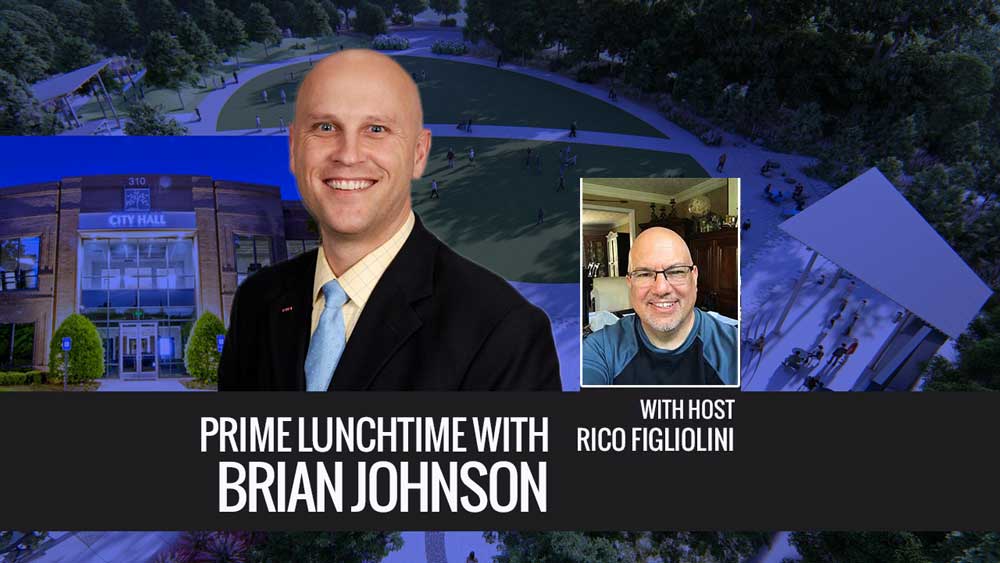
City Manager Brian Johnson joins Rico Figliolini to discuss a possible Micro mobility Transit Hub, e-scooters, LG – MRI, Special Service Districts and updates on the pedestrian bridge, the Indigo Hotel, license plate recognition cameras and more. Recorded at Atlanta Tech Park in the City of Peachtree Corners, Georgia
“A lot of what that is driving that lately tends to be around Curiosity Lab as we know it’s serving the very purpose that it was created to serve, which is to become a magnet for companies… But a lot of what we’re doing in the economic development arena is taking the Curiosity Labs environment that we’ve created and talked to companies about how they can use it”
Brian Johnson
Related Links:
https://www.curiositylabptc.com/
https://www.hargrayfiber.com/
Timestamp:
[00:00:30] – Intro
[00:02:42] – LG Tele-scooters
[00:16:39] – LG MRI
[00:23:19] – License Plate Recognition Cameras
[00:40:22] – Redevelopment Authority
[00:44:03] – Pedestrian Bridge
[00:46:22] – Indigo Hotel
[00:47:17] – Fiserv Property
[00:47:31] – Peachtree Corners Festival
[00:48:44] – Workforce Housing
[00:51:40] – Closing
Rico: [00:00:30] Hi everyone. This is Rico Figliolini, host of Peachtree Corners Life and this show once a month with Brian Johnson, the City Manager. It’s Prime Lunchtime with the City Manager. Hey, Brian.
Brian: [00:00:39] How are you?
Rico: [00:00:40] Good. Good. It’s been awhile. We’re going to go through, let me, let me talk about my friends though. Our lead sponsor. So my friends had Hargray Fiber. They just became a lead sponsor, and I want to tell you a little bit about them. They are a company that is not unique in the space, but provides unique solutions. So they are a fiber company business to business. Just moved into Peachtree Corners that based out of Savannah and Hilton. They craft customized solutions for hundreds of businesses throughout the Southeast. They are working with small businesses to provide affordable bundled services and enterprise level businesses that are looking for a full suite of managed IT services. So Hargray Fiber can customize those solutions to work best depending on what your company and your industry needs. So an amount of that industry, Internet, high quality TV, phone solutions. They’re the ones to do it. They have a local presence. You don’t have to worry about the cable guy. They will be there and they are community friendly and they are doing lots of outreach to the city of Peachtree Corners.
Brian: [00:01:46] I’ll just say, let me add one more thing. Hargray not only has their office in Tech Park. But they are the fiber provider, the official fiber provider of Curiosity Lab. So if you think of all the technology that we have, or we’ll be talking about and Curiosity Lab, be it 5G. Which, you know, people are like, wait a second, 5G is wireless. Well, the wireless, the 5G antennas that spit the wireless signal out have to be powered by something and they’re powered by a fiber line and it’s Hargray, the backbone of Curiosity Lab. All the technology, the backbone of it is the fiber line that Hargray provided. So it would, it literally, none of it could work without a fiber optic cable that Hargray provided is, wouldn’t be working. So they’re a key part of Curiosity Lab.
Rico: [00:02:42] Excellent. And if you want to find out more about Hargray, just go to HargrayFiber.com. That’s HargrayFiber.com. And we’re on, we’re in Atlanta Tech Park and this podcast studio is here at, which is in Tech Park, Atlanta on the road of Curiosity Lab that went on the test track. So this is cool. In the midst of this, we’re going to be talking about a lot of things going on, high tech and and also keep an eye out for Peachtree Corners Magazine. Our next, this should be out in another week or so. And we have a cover story on companies here on Peachtree Corners, innovative technology driven, and a big part of this community. So, we’ve been, I think, it’s been about a month maybe that we have, haven’t spoken since. I mean, you’re on the show on the podcast. So there’s lots going on. And guess what, we were talking ahead of the show about something going on there. Reminds me of Bladerunner, for some reason. It’s just the technology to be able to see the big images of things on, in the public realm and public streets and stuff. Tell us what’s going on with the Tele-scooters with LG specifically that you met with, that’s going to be out there that people can see.
Brian: [00:03:58] Well, you know, part of any city’s operation is economic development. You’re always wanting to make sure that, you know, the businesses you have are healthy or attract new business. And so you, you know, cities do that. We do that. A lot of what that is driving that lately tends to be around Curiosity Lab as we know it’s serving the very purpose that it was created to serve, which is to become a magnet for companies to either come to Peachtree Corners on a temporary basis, you know, even for the day to use or, or tour or whatever. And you know, we at least know that if they’re here for one day, they got to eat lunch and they’re going to eat in our restaurants. And you know, just a couple of days in our, our, hotels, we’ll get, you know, the indirect benefit of revenue from them. But a lot of what we’re doing in the economic development arena is taking the Curiosity Labs environment that we’ve created and talking to companies about how they can use it. And we’re getting ready to unveil the next very unique user of Curiosity Lab, which is the tele-operated E-Scooter. And so…
Rico: [00:05:14] Which is available now, actually even, right?
Brian: [00:05:16] No, not quite. Not quite. You may have seen them out there, the company getting ready to, to task, but the way it’ll work is we all know what an E-scooter is. A lot of controversy lately about E-scooters in cities. Especially in Atlanta, where you’ve had two things that have created problems. One, of course, is the users of the scooters, not obeying traffic laws or being cavalier. Too fast on sidewalks when they shouldn’t have been on sidewalks at all. Or I’m trying to zip in between automobiles and they get hit by, you know, so the, unfortunately, unlike the drivers of automobiles, irresponsible drivers, you can’t. You can never overcome. But the other aspect of E-scooters that are frustrating is the fact that people will leave them wherever they want. And the difficulty and the overhead costs of the company that owns a scooter, repositioning them for more people makes it difficult. And it frustrates people when you’re walking down the sidewalk and there’s, you know, 12 E-scooters all over the. Well, the company and it’s two companies that joined forces for this that are going to be testing a way to maybe address that issue is. We’re going to have tele operated E-scooters. And those are E-scooters, like you could buy from, you know, whatever, you know, sporting goods store or whatever. And they have been retrofitted with a kit that adds two little training wheels to the back so that they can stand on their own. Because most of them are just, you know, two wheels so they can stand on their own and a camera on the front stem and when necessary, the E-scooter can be driven by a human from a remote location via the camera that the, that they’re viewing through the, so in this case, the company has a tele operation center in Mexico city, and so they’re going to have, it’s almost like a call center. Where you got people sitting at stations and when it’s time for the E-scooter to be activated, you know, from a distance, they can then have the screen go live. The consumer takeover and drive the East scooter and how that’s gonna work is they’re going to look at the scalability of doing this for two reasons. One, you can summon the scooter, like an Uber or Lyft. And so they’re going to have an app that if you want to do it for, if you work in Tech Park or you want to do it just for novelty sake, you can have the scooter come to you. And then you jump on it and you drive it like any other scooter. That’s one. And the other one is, is they’re going to, the companies go into look into whether or not on a
large scale by large scale, they’ll get up to about a hundred E-scooters, but no more than that. They’ll see if they can reposition the E-scooters from that Mexico city location using tele operation and not have to get up truck and two guys driving all these locations.
Rico: [00:08:52] Which is a big economy in Atlanta cause that’s what they’re doing in Atlanta.
Brian: [00:08:55] That’s correct. That’s what they have to do everywhere because what other way would they reposition them?
Rico: [00:09:00] So 5G actually helps it because there’s no latency, really, or very minimal?
Brian: [00:09:06] I think so. Yeah. For all intents and purposes, none for that. So that’ll help. And then they’re also testing, because you know, 5G will take a while for it to get their testing. The ability to transition from 4G LTE to 5G and back and forth. And then, so they get to test that out. And then what you refer to at the beginning is this got back from talking with a local company called LG MRI, which makes LG exterior televisions screens, whether in, it could be touch-screens or, or what, but they make it specifically for the outdoors. And we are talking about maybe partnering or, or having a collaborative effort between a number of companies. In the case of LG MRI, they would provide touch-screen televisions at the bus stop and we would also integrate this kind of micro mobility transit hub. It would be a bus stop, a real world bus stop that Gwinnett Transit…
Rico: [00:10:12] That already exists.
Brian: [00:10:13] Gwinnett County transit has, exists. Who would have the, you know, the bus stop shelter cover would have solar panels and those solar panels would provide the electricity for the LG screens and we’re going to integrate a docking station for the E-scooters into this. And so you could invariably ride the bus to this spot and then jump on the E-scooter to do that last couple hundred yards or whatever to your office, or vice versa. When it’s time to go home, if you’re going to go home via bus, and this is like real world buses isn’t like a, you know, coming to people testing, this is a, yeah, but, and these scooters are going to be available to the public.
Rico: [00:11:05] Anyone that’s within technology park?
Brian: [00:11:07] Well, no, you can come over here and just use it for novelty if you want, but I’m just saying, you know, you can actually get on and so, but let’s say you work in Tech Park. I mean, you could some in the E-scooter to your office through an app, through an app. It gets there. You jump on it, you ride it to the bus stop. You put it in the docking station and then when the bus comes, you get on the bus while you’re waiting, you can either see at, you can use the interactive kiosk, you could find out how far away the bus is, you can do all sorts of things.
Rico: [00:11:40] That might be cool to be able to see real live, 10 minutes away. And then also it’s going to be able to play probably commercials or all the things in big huge screens and stuff. That’s the part that reminded me about Bladerunner for some reason.
Brian: [00:11:56] And you know, this kind of stuff, these companies want to, you know, be involved in creating, you know, call it the bus stop in the future. We have all these things together, you know, inside these screens and these television, exterior television screens, the LG MRI, people call it their chassis, but it’s got a container basically. That houses all the components inside and it’s completely watertight and it also cools the interior components.
Rico: [00:12:30] So even if it’s a hundred degrees outside.
Brian: [00:12:31] Even if it’s a hundred degrees, it’s good, but it also has the capability of adding third party devices inside the box. To provide lots of things outside of this one box, including like DSRC roadside units, 5G small cell antennas, wireless access points. All inside of this box and the television that it will, the entire, you know, kind of all in one module also has edge computing. So it actually can compute certain things. It has a degree of artificial intelligence and computation ability at that location versus having to go, you know, somewhere to some brain somewhere else and come back. And so it could, so these companies are loving this sandbox we’ve created. For them to come play. And so we’re kind of like being a, to a degree, a, a matchmaker, you know, we’re, we’re talking to, Hey, they’re doing this and what about you doing this? And we’re kind of like the matchmaker that owns the house and we’re like, you know, or owns a restaurant. We’re like, why don’t you two get together and you can come to our restaurant and have your date where we’re telling them we got some property here. No, he’s saying to come here, we’ll kind of facilitate. We’ll let you tie into certain things.
Rico: [00:13:51] And you know, it’s a cool, it’s almost like I could almost see at some point, you know, asking Gianna, or Emma, what’s the temperature now and how far is that bus? It’ll answer that.
Brian: [00:14:00] Yes, yes, they have that. So, you know, here’s some interesting stuff. So these units, when we were talking to them, they have deployed these units recently at the entry points. To Taylor Swift concerts. And what they’ve done is the screens have been displaying imagery that’s of some interest to people going there. And inside the box is facial recognition software. And when people are looking at the image, it will take and get us a snapshot of their face. And it scrubs that against databases that I guess the Taylor Swift security team has for people who are on, kind of call it a watch list for her like that. Then there’s a restraining order against them because they’ve been stalking her. They’ve made comments on social media sites about her. They’ve been, and so these celebrities have people that do that, and so they’ve been able to identify people who have posed or have a high potential, suppose a threat to her. So that helps them. Sure. It’s being done on a private, private venues. So there’s not this whole, you don’t have any, you know, they voluntarily went to this for.
Rico: [00:15:30] Sure. It’s not a public thing.
Brian: [00:15:31] No, it is not a public, they buy a ticket. And they know. Right. And so I’m at a private, you know, concert venue. But then the security team knows, and I actually don’t know what was done about it. It could have been, they just kept an eye on him. It could’ve been that they were asked to leave because of, you know, I know that the team, you know, the, the, the company that provided this housing, this chassis for all this technology did say that, you know. They, it identified some people who there was a restraining order against, because they had been convicted of stalking. So maybe there’s those rests leave. But anyway, the other interesting thing is the concert venue insurance requirement.
Rico: [00:16:15] Did that go down?
Brian: [00:16:16] Went down because the insurance company was like, you know what? You are minimizing risks for things, so you don’t have to have as many. But the unique part of this is this, is technology that’s housed in one water tight, secure unit, and it’s using multiple things at the same time to further.
Rico: I mean, just interested in the, you know, at home, if you have an alarm system, of course your home insurance will be discounted. So similar. And it also introduces, I mean, this is great. I mean, I’m, I’m all for this, certain people are like afraid of the technology to a degree. And there is even talk, I don’t know if this is, I think this is in England, Europe at this point. But you may come across the ocean to us to talk about moratorium and facial recognition, recognition videos because of in the public realm, in the public space. Because of privacy concerns and stuff. And I know, you know, so our next and next thing, and this is cool, so that was the LG MRI?
Brian: [00:17:20] Yup.
Rico: [00:17:20] So people can Google that and find out more.
Brian: [00:17:23] Yeah. I mean their, their manufacturing plant. Fascinating. They had just asked us to come over and meet and they wanted us to show the, show us their site too, but they are going to have, they also are interested in hanging digital, digital screens on the side of light poles like you see out here now that are the banners, they make, ones that you can have digital. So you can have all sorts of messaging on that and it’s not the same thing. So yes, it is. So they’re going to do that stuff. So today was, they were like, we’re going to do something where can we put things as we told them, here are the areas of our sandbox. You can do things. And so we’re going to have another meeting in a week or two where they’re going to come back and say, we would like to do things here, here.
Rico: [00:18:15] That’s amazing, I bet you didn’t even think about that. This and that at this point.
Brian: [00:18:18] There’s so much of this that I didn’t even know. I mean, some of it’s really cool, like, wow, you know, I didn’t realize that technology is here. Some of it is in technology that I thought was farther along than it is. It’s represented that it is, but when you get into it, it’s not quite as, so I’ve had both, but yes, I mean, so just unique things that can be done in a, in a, you know, using technology, especially when you pair a bunch of them together.
Rico: [00:18:47] The, so let’s, let’s go into, because. This past Tuesday, city council meeting, a few things went on that LG MRI that was really all support allowed because of what you passed just recently. The micro mobility, a piece of it.
Brian: [00:19:02] Yes. So for us to have E-scooters operated on, because currently E-scooters, haven’t really been addressed by the city much. It was addressed in our entertainment district ordinance in it for it prohibited E-scooters, essentially in our entertainment district, which is our town center and kind of that area. Other than that it’s not addressed. So theoretically, you know, somebody could go buy one and go out there, but we had to address it in some way. But because this is a pilot program, it’s testing or whatever. What we did is we created the programs similar to kind of how we regulate other activity within our right of way. Like if a telecommunications company wanted to come in and do work in our rideaway, like very cable, we have to give them a permit to do that. We did the same with the E-scooter, created one for a scooter so that they can have, that can be the activity that they are involved in in our right of way.
Rico: [00:20:09] Is that a sunset rule also?
Brian: [00:20:11] It is. So it set a couple of things. One is initially it’s just a curiosity lab. Two, it is a year long pilot program. Three, it has to be geo-fenced. So there has to be, the technological capability of having the E-scooter shutdown if it gets outside of a previously defined area. So if you tried to drive it up to the town center, at a certain point it was shut down. Similar for the golfers out there, sometimes you get on a golf cart has GPS and you’re supposed to be cart path only and you get off the car path, often times it’ll shut down or it’ll go real, real slow until you go back. And so similar. And then we also require this permit. Requires the E-scooter operator to have tele operation capability. And because E-scooters in general don’t need to be tested, I mean they work, right? This is the test part. The reason there’s a lab that’s needed is because of that tele operation. So we’ll start on that and if it works out, we can always expand the boundaries a little bit. Would love to create a scenario in which you could have E-scooters go from the thousand plus hotel rooms we have at the south end of Curiosity Lab between the Hilton, the Marriott was a Homewood suites in Hampton and the town center for that. I mean that’s, there’s a, that’s a need base between the two, especially Sunday or Thursday night,
Rico: [00:21:48] 141 because those sidewalks.
Brian: [00:21:50] Potentially, I mean, state law, there are some, there’s a lot of in the, in the Georgia General Assembly. Is currently considering legislation on defining certain aspects of
E-scooters. So we’re keeping an eye on that and made reference to our permit, would permit it would have to adhere to all state and local laws on E- scooter. So if that tweaks things, you know here soon because the General Assembly did something. But anyway, that’s kind of how it will operate. But they’ll get ultimately up to a hundred scooters and they are available to the public as just like any other e-scooter. Well, I don’t know if it’s free. They may end up having a slight, okay. They might, we’ve encouraged it not to since it’s a pilot, but that’s not our decision. So we don’t know that yet. But yeah, but. If you do get on it, you know it. It’s, it’s an off the shelf E-scooter that they’ve nearly outfitted with a camera on the front stem, training wheels on the back, which as an operator of it, you don’t deploy, they deploy it remotely. So it’s just like any other ones. If somebody’s been on a bird or a lime or do the same thing, it’s just that when you’re off of it, the company may on its own decide to move it somewhere else.
Rico: [00:23:19] So we were talking a little bit about the micro movability part and stuff like that too. So there’s gonna, you also discussed the, license recognition, facial recognition. cameras that are going to be deployed. So did that come to fruition did the city council decide on a plan on how that’s going to happen?
Brian: [00:23:39] So at the council meeting, we had the first read of the final bill. Final vote will be at the February council meeting, but the council had the first read of an ordinance creating the, or it’s really activating the city’s ability to create what are called special service districts. What that is, is, home rule municipalities in Georgia have the authority to create a special service district and they can define the district how they essentially see fit. And inside this district, there can be unique things that happen inside this, just this district for a specific service. An example of that would be you could create a special service district for public safety, and you could do things inside of this special district that were specifically aimed at improving public safety. So doing things like installing video and license plate recognition cameras, installing streetlights, those are things that improve public safety. That special district can have unique things about it. For instance, it could, council could say, install a bunch of streetlights on a street that was dark, that was not a connector street, one that did not serve a true public purpose. So a neighborhood street that maybe was a residential street that had houses on it, and a dead end. But the mayor, if it had problems there, the city could install streetlights on the street and then take the pro rata share of the cost of the streetlight and equally distribute it amongst all the homes that benefit from the surface or all the apartments, as the case may be the apartment units.
Rico: [00:25:47] So now volunteering to be part of that if someone wants to, if a subdivision wants to be part of that and volunteer, you guys have set up percentages or ways to do that?
Brian: [00:25:58] Yes. So, and you know, you’re referring to the fact we’ve talked about before, that this ability to create a special service district gives counsel the ability to determine what threshold that would be required before they did it. We can start with kind of the fact that council can impose it.
Rico: [00:26:19] Wow. Okay.
Brian: [00:26:20] If it against, in other words, that it doesn’t have to be a threshold. They have that authority. I’m not saying they will, but they can’t. And then I will give you examples of that where they may one day. Yes. An apartment complex that has a crime problem. That has been, you know, there’s been some issues or whatever. They can decide, you know what, you don’t have enough street lighting, so we’re going to put street lights in there.
Rico: [00:26:47] Even though it’s internal, internal to that apartment complex.
Brian: [00:26:52] Well, as long as the city streets are public, you know, you could do it in there. If they’re private, private streets, internal to that could, but the council could put it at the entrance.
Rico: [00:27:02] Okay. But with them, because apartment complexes have their own streets and driveways.
Brian: [00:27:07] If it’s truly private. Some of them are public still. There’s a lot of neighborhoods and having, you can look at them as interior streets, but they’re really the city.
Rico: [00:27:13] Well, for sure. If the city’s going to pay them. They’re public streets.
Brian: [00:27:16] Correct. I promise you that we’re not paving streets that are not, most streets in the city are, are public. There are very few that are not in there. Very, very few that are private that are not behind a gate. Very few. There’s only a handful of apartment complexes that have a labyrinth of streets interior that are not public.
Rico: [00:27:37] And they pay for their own.
Brian: [00:27:38] And they pay their own, and most of them, maybe all of them are behind the gate. Then they’re private.
Rico: [00:27:44] But inside that gate on the public street.
Brian: [00:27:47] The city could do a number of things. It could light it up, you know, prior to that. But a good example, you know, but so the streetlight one, say there’s apartment that a city streets and the city didn’t feel like there was enough lights. He could do that and then put it on the property owner. The landlord to pay it. You know? I’m sorry, your crime rate is too high. It’s unacceptable. We think one of the things that would improve public safety is better. Lighting cause there’s been maybe, you know, problems in the parking lot at night or whatever and we’re going to do that. Or another one would be in, this could even apply to an apartment complex that has a gate. And so the interior streets are, but there’s a lot of criminal activity coming and going. The city could decide to put a camera at the entrance so that all the cars coming and going got picked up by that camera. And it could create a special service district around that
area and in that district, they can charge the property owners for that camera because it’s a Public safety.
Rico: [00:28:48] So what’s a threshold to volunteering?
Brian: [00:28:50] All right, so volunteering, that’s where council probably between now and February, make the final decision cause it’s only had the first raise, but they’re really leaning towards probably a 70% threshold. I think, you know, the 50% plus one, they kind of feel like that’s, you know, just too close. And they, most of these, they feel like, look, you ought to have a super majority for us to, for them to feel kind of like, ah, you know, this is good. And so there, there will be an option here for a community to ask the city to do something because it’s unable to do it itself. And that so they could exercise a referendum kind of component.
Rico: [00:29:45] Which is to become a special district?
Brian: [00:29:47] Right? For a particular purpose. And so there’s really three things, three services as we envision it. There could be more in the future, but really three that may be a service that results from these districts. One is the camera, video camera, license plate recognition to a streetlights, and three, your speed bumps or traffic control devices. Speedball bobs or speed humps, as the case may be are usually the one that cities don’t like to just put it in because it affects a lot of people. We tend to want to have a lot of buy in from the community, if, if to put it. So those are ones that we envision being a service that we, the city can provide either voluntarily, where a community comes to the city and says, here’s proof. You know, we did a referendum, and here’s proof that 70% of the property owners want it. Or the city could decide to do it because it’s just, there’s too much problems for whatever reason. There’s too much speeding and, but, but the local, the local residents, and we have this in a couple of places where the local residents can never get enough property owners because they’re renters and the owners live out of state and they don’t want to. So it can be one where the city council just decides, you know what, it needs it. We’re just going to do it.
Rico: [00:31:16] But the city council has to vote.
Brian: [00:31:18] Oh yeah. City council has to vote.
Rico: [00:31:18] It’s not like some regular department decides.
Brian: [00:31:22] No the city, no.
Rico: [00:31:24] Okay. So like a special use permit. Does it go through planning commission or is it straight to say?
Brian: [00:31:27] Oh no, I don’t. I think it’s straight to city council on those because, yeah, I mean, it’s really not a land use really how it operates.
Rico: [00:31:36] So the cameras are really license plate recognition, not facial recognition.
Brian: [00:31:40] Well, no, there won’t be any facial recognition on this.
Rico: [00:31:43] And like we discussed before, this is really stored for a certain period of time. No one can see it or use it unless there’s a crime or something pursuant to it.
Brian: [00:31:53] the, the way that it will work that we envision it a work is, and there’s one other way that you can end up having this happen in that is they’re considering, homeowners associations that uniquely fit a unique, qualification. And that is really, essentially, they have officers that have been elected and they own property that can receive a, that, that receives a property tax bill. Because if that, if they meet that threshold, they could request a camera. Like at the entrance to a subdivision that the HOA owns, and then the city can build that HOA through it’s property tax bill nature way. Then can take a vote and officially ask for the city to install a camera.
Rico: [00:32:47] I’m just curious because can they request the probe one near the swimming tennis, for example? Within the subdivision.
Brian: [00:32:55] If the city owns property. If you could put it in the public right of way, so it’s not a private street. And the HOA gets a property tax bill, then yes. Invariably there could be a yes, put it here. And so all that being said is you are bringing up, so the way that mayor and council are envisioning the way that I ultimately proposed is when these cameras go in. If there’s a request and all the things, the city is not going to end up having access to the data ever. It is going straight to the cloud in Gwinnett County PD. And the cloud access by gonna County PD. And the only way Gwinnett County PD access is it is if there’s a police report filed.
Rico: [00:33:56] Not even for that it recognizes a plate that may be.
Brian: [00:34:00] No, that would be automatic. I’m sorry. So yeah, you’re referring to when Gwinnett County, sometime in 2020 will have that special division that’s stood up. Our license plate recognition cameras will then communicate directly with Gwinnett PD. And if a license plate that it takes a photo of comes up hot. That there’s a warrant for that vehicle. For some reason it was reported stolen. It’s an Amber alert or really invariably, what most of them come up hot for is no insurance or expired tags. But that’ll automatically go to Gwinnett PD. And Gwinnett PD will make a case by case decision on whether the license plate coming up hot is worthy of moving assets around specific to it. But we do know, having talked to other communities who have just put this in place that, you know, with like the insurance and expired tag stuff, it was just to me, is not gonna end up in variably having anybody do anything different. But you could get like an Amber alert would be a good one. They will immediately deploy assets upstream of the direction of travel of that vehicle, at least where the direction of travel, when they got the photos.
Rico: [00:35:19] Because it’s real time, it’s getting out there.
Brian: [00:35:21] It is real time that’ll happen. But when it comes to you, even that photo, well not be accessed by anybody other than Gwinnett County PD. So a photo was taken and they may send a message, but every photo, every license plate photo is taken here and will go to the cloud. And it’ll sit there. I want to say it’s 30 days. It’s written over. So the storage is only for 30 days worth. And then day 31 starts recording over the very first day in that. But the video and the photos of the license plate are going to a PD. The city will never have access to it. And if somebody wants historical imagery or video from that, they’ve got to file a police report. And the reason to do that is just to avoid the, you know. Not to say that I wouldn’t want to do this, but, you know, say my daughter, you know, when she grew up was, you know, snuck out or whatever, and you know, you wanted to find out who, you know, came back, things like that. But it just, it’s so ripe for abuse on those kinds of things. So mayor council, and that’s his staff’s decision. It was just like, you know what? We’re not in it. It goes directly to the cloud. And it stored for that period of time before turret. And if somebody files a police report, they get through good PD access, and then Gwinnett PD can come in and they can use it to investigate. But we’re not in it.
Rico: [00:36:49] And I think the way you set it up, you know, no one can really argue too much about that as far as privacy goes, because the only access point would be if there was a crime. And that’s…
Brian: [00:36:59] Well, it’s gotta be something worthy of a current, a police report.
Rico: [00:37:02] Correct. And that’s reasonable. I don’t see anything wrong with that. You know, facial recognition in a variety of ways could be an issue at some point. But, but not that.
Brian: [00:37:11] And these do not have that. None of these have nothing capabilities of those, we’re not getting any cameras that have facial recognition.
Rico: [00:37:18] So there’s not even a capability to upgrade.
Brian: [00:37:21] Not the cameras that at the camp we’re getting. These are Georgia power. These are cameras do a Georgia power program called site view. So this isn’t like fly by night or this isn’t, this is a program they have created and they hang these cameras. And the reason they did this is because they can generate money. They hang these cameras on their light poles or trap or their utility poles. So there’s already power there, right? And we don’t buy the cameras. We actually lease the cameras monthly. And so monthly we pay it. But what we get for the monthly cost is it’s an all inclusive. We don’t have to do anything. We never had to pay up front for the camera. We don’t pay for the cloud storage. We don’t pay for the electricity. And if it breaks, we don’t pay to have it repaired.
Rico: [00:38:14] You’re just paying a leasing fee.
Brian: [00:38:16] Right. And it’s how our streetlights currently exist. And so it’s a pretty common, but so this isn’t like self love, but this is Georgia power, a public service commission, regulated utility. But no, it doesn’t do facial recognition. And I will tell you, if it did, the amount of storage that you would have to have and the amount of edge computing you would have to have for there to be. Analysis done, and a database to pull facial imagery to enter the store is, is not even.
Rico: [00:38:52] It’s different from being able to use an assistant like that to count bodies.
Brian: [00:38:57] That’s correct. So it’s not, we have that capability at the town green. They just count. All it can do is differentiate between a human and a vehicle. So it’s counting people. That’s why when you know, I say there’s a, there’s any, and even then there’s a little bit, because it doesn’t know enough to not count you twice over really, right. I mean, but on a concert, we can kind of take snapshots of how many are there at a time.
Rico: [00:39:23] Non moving. Okay.
Brian: [00:39:25] So the, we can kind of get a pretty good idea of how many people in there, but if we had it like say at the, I don’t know, a door of a restaurant or the restrooms or whatever. You know, if you’re in and out, in and out, it would count you all the time. So you have to still, but no, we don’t have, again, it takes a lot of, takes a lot of juice. To make that to where it’s really working cause you got to be pulling from a database because to recognize your face, it has to have your face somewhere. Then it’s got to have the ability to take a photo and then pull distinct marks like a fingerprint, and then it’s got to be constantly scrubbing the face image that you just came on there against, God only knows how many images out there and oh by the way, it’s taking photos, all these new ones doing it. It’s just that a lot, it’s out there. The technology is out there. But we don’t have anything close to that, at all.
Rico: [00:40:22] Okay, cool. Let’s, let’s move on a little bit to, cause we’re getting towards our time a little bit, but I want to touch on a few other things. The redevelopment authority, you’re doing a plan for that, right? But you said would take about 12 weeks, you’d think three months we have to pull it together.
Brian: [00:40:40] So the State statute that allows cities to create redevelopment authorities, has some requirements in it. And mayor and council have made the decision that we’re going to create a redevelopment authority. I’m going to start concentrating on some of the redevelopment needs and opportunities in the city. You know, by redevelopment. It’s really, you know, taking a parcel that has been developed in one way, shape, or form at one point in time, we don’t have a lot of vacant stuff, so most of it’s still operating, but sometimes it’s just not quite as great of a use as we would like or whatever. And so redevelopment opportunities and redevelopment authorities have certain tools at their disposal that the city government itself
does not. Very similar to ride downtown development authority, which we have and has own property, has entered into an agreement, has incurred debt, and so it has a lot of the same powers. Although you know most of this stuff as anything in life goes, you know, the oil that makes activity work as money. You know, so these authorities need money. It’s usually the city having to appropriate money to them, but the redevelopment authority does have certain tools like access to grants that the city doesn’t have. It does it directly, and it can, it can negotiate a sole source without having to bid it out in something. By law having to go to the low bidder. Sometimes a little bidder is not the best one.
Rico: [00:42:18] For sure though.
Brian: [00:42:19] But the city doesn’t have a choice. They do. But anyway, this state statute laying out all of the requirements for redevelopment authority exists require that there be a redevelopment plan that is in place before you create the redevelopment authority, because redevelopment authority will be created to execute the redevelopment plan. And maybe amend it, but that’s the original plan is and so we have to start with doing a redevelopment plan. So council is, you know, we set the wheels in motion. We have, we interviewed firms and we selected a firm and they’re going to start on the redevelopment plan. Given the history of us collecting and organizing, compiling data in certain things that are necessary for a redevelopment plan. We’re actually a lot farther along than we thought, so it’ll only be about 12 weeks or a full blown one to be done, including some public meetings. That will be advertising to come in and hear about, you know, where the plan is, and you know, the plan will have everything from areas that should be part of the redevelopment effort. It doesn’t have to be, it probably doesn’t. It probably won’t be all of the city. It’ll be targeted areas for targeted reasons, and so there’ll be some public opportunities for people to weigh in. And I’m at a certain point, council will approve that plan and then turn around and immediately start populating the redevelopment authority and get it populated, and then they’ll adopt their bylaws and a way they go.
Rico: [00:44:03] Right. A lot going on there. So I wanna also hit on a few things quickly because we don’t have that much time but I want to be able to sort of get an update, let’s say. Pedestrian bridge. I see the pillars going up. How far along are we really?
Brian: [00:44:18] I mean, you know, we have issued the order to start fabricating the span, which is being done off site. And of course you see the two, you know, ends going up. A lot of concrete, you know, and it’s intricate cause there are elevator shafts in there. But that’s being formed and poured. We’re still hoping to have the span dropped on site sometime maybe in May and dropped on site. So they’ll have the span, but then we’ve got to start attaching the sides because you know, it can’t be just like a, a little railing. This is over a very heavily traveled roadway. Georgia DOT has to permit this whole thing. Because it not only is over their roadway, but the two towers are in their right of way. So it has to be permitted by them. And so they’ve got to inspect this to certain points. And so the span will come out. We’ve got attach sides that are, have small enough openings that you can’t throw things out into traffic.
Rico: [00:45:33] Right. And then assignments to essentials.
Brian: [00:45:35] Well, there’ll be, there’ll be letters spelling out Peachtree Corners right. But, and then you’ve got to pour the floor cause it’s steel fabric, and then they’ll set it in place. Everything. So, I mean, you’re still, you know, sometime in the summer we, it should be done, but it’s moving along. You know, well, I mean, of course, you know, it’s got to get State approval at various places. So, and weather’s always a factor in everything, and it’s a little bit slower because we’re not wanting to close lanes to do any of this. So, you know, there are certain things that it would move faster if you could, but we’re not going to. So anyway, but you know, some or some time this summer is not bad.
Rico: [00:46:22] All right. And what about, we were talking about the Indigo hotel, possibly the apartment complex there, the 12 town center. Is that moving along any, any more than what we discussed last time?
Brian: [00:46:35] I mean, the owner and the ownership group raised over $23 million, something like that for the effort. That’s official fact. They’re already starting to issue quarterly reports to all of the investors. So they’re holding their money that much. I do know. So if they weren’t serious, I don’t know why they would go out and raise that much money only to have to give it back.
Rico: [00:46:59] So the $23 million will actually fund both those buildings, the whole thing.
Brian: [00:47:05] And so I, yeah. It looks like it’s moving. I mean, you know, they haven’t submitted for any permits or anything yet, but then there’s, you know, there’s a lot of work behind the scenes that go on some of these things.
Rico: [00:47:17] The old Fiserv property, I understand earth is moving or things are being done there?
Brian: [00:47:22] Demolition of existing buildings is, is happening. It is moving forward, phase one at least.
Rico: [00:47:31] All right. And then, I hear this, the Peachtree Corners festival is going to be at town center this year?
Brian: [00:47:37] It is.
Rico: [00:47:38] And there’s plenty of space. Good, good, good. Is it going to be, are we going to be closing off the street? I guess Peachtree Corners circle?
Brian: [00:47:50] Yeah. So it looks like for it to be, for it to have enough property, we’re going to have to bring into play the section of Peachtree Corners Circle in between Medlocke and
Peachtree Parkway. And close off some of it. There’s the, you know, I don’t know if it will be for Medlocke, just to the entrance to DaVinci court. Probably that’s probably what it will be done then DaVinci court’s parking lots might come into play, but you know, like the car show and the vendors setting up, you gotta have a lot of space. And then we use the town green as the concert space. And so I think the link between the two will be, well, I think it’ll be good. You know, and I know the businesses want it.
Rico: [00:48:44] Oh, I’m, I’m sure. I mean, you know, the businesses are, you know what I’m seeing more you know, everyone’s doing their bit to gather more business. You know, it’s just the zone. You can’t even hire enough people it seems with some of the businesses, especially the restaurants it seems to be that there’s just not enough people to hire to do the work.
Brian: [00:49:08] Well, I mean, that’s a whole different, you know, it’s a whole different conversation about workforce housing. You know, communities love having lots of service related, you know, amenities, restaurants. Good stores, you know, boutique stores, entertainment, but they have to have people working in them that are in the service sector. And service sector doesn’t necessarily make a lot of money. And so sometimes it’s hard if you’re in that, you know, if you’re like working in a restaurant in an affluent area. You can’t live close to that because you can’t afford to.
Rico: [00:49:47] So is the city looking at solutions for that?
Brian: [00:49:49] Well, I mean, yes, we’re always looking to have as diverse of a housing stock as we can. Just like we want a diverse local economy. The trick there is to find the right locations for all of that stuff. And so, but, but we are, but yeah, I mean, the other thing though is we’re kind of in that unique point in time, we just added a bunch of new stuff, which means the, what existed prior to that is kind of sharing. Then you’ve got this extra, this extra, you know. Fight for finite resources. And we’re not in that final stage of all of the local rooftops. You’ve got 75ish townhomes that still have to be built. They’re starting. You can see some of them coming out, but you know, that’s, that’s people that are right there. And then you’ve got 250ish shower, many units that were in the pedestal. Apartment complex on the Robert’s property. They haven’t started yet, so that’s a lot of rooftops. We’re calling residential units that are right there in town center. That’ll help. And then we also haven’t connected the form and town center yet. So right now I felt that there had been times where I may have walked to the other side for something, but because I can’t easily, I just got by, I said, screw it. I’m not gonna do that right now. Whereas if you could’ve just walked across, that probably would have. So linking it all together. So we’re hoping to just get through this transitionary period and everything is relatively, you know, the same. And then at that point, I think we’ll have a good base for customers.
Rico: [00:51:40] Yeah. Yeah, for sure. When there’s, especially these shorts bridge road, the old Fiserv property, more, more stuff going on there. This has been Prime Lunchtime with City Manager, Brian Johnson. I appreciate the time you’ve given us.
Brian: [00:51:52] Thanks for having me.
Rico: [00:51:53] We’ve been at the Atlanta Tech Park here in the city of Peachtree Corners doing this podcast, talking about all sorts of things from mobility to development and retail and business. I want to say thank you again to our friends at Hargray Fiber. Who has been, not only is a lead sponsor of this podcast and the family of podcasts, but also a big part of Curiosity lab and Peachtree Corners. So thank you for that. And you can find more information about Hargray at HargrayFiber.com so appreciate it. Thanks everyone. Take care.
Related
City Government
Brandon Branham Honored for Transformative Leadership in Peachtree Corners
Published
1 week agoon
May 20, 2025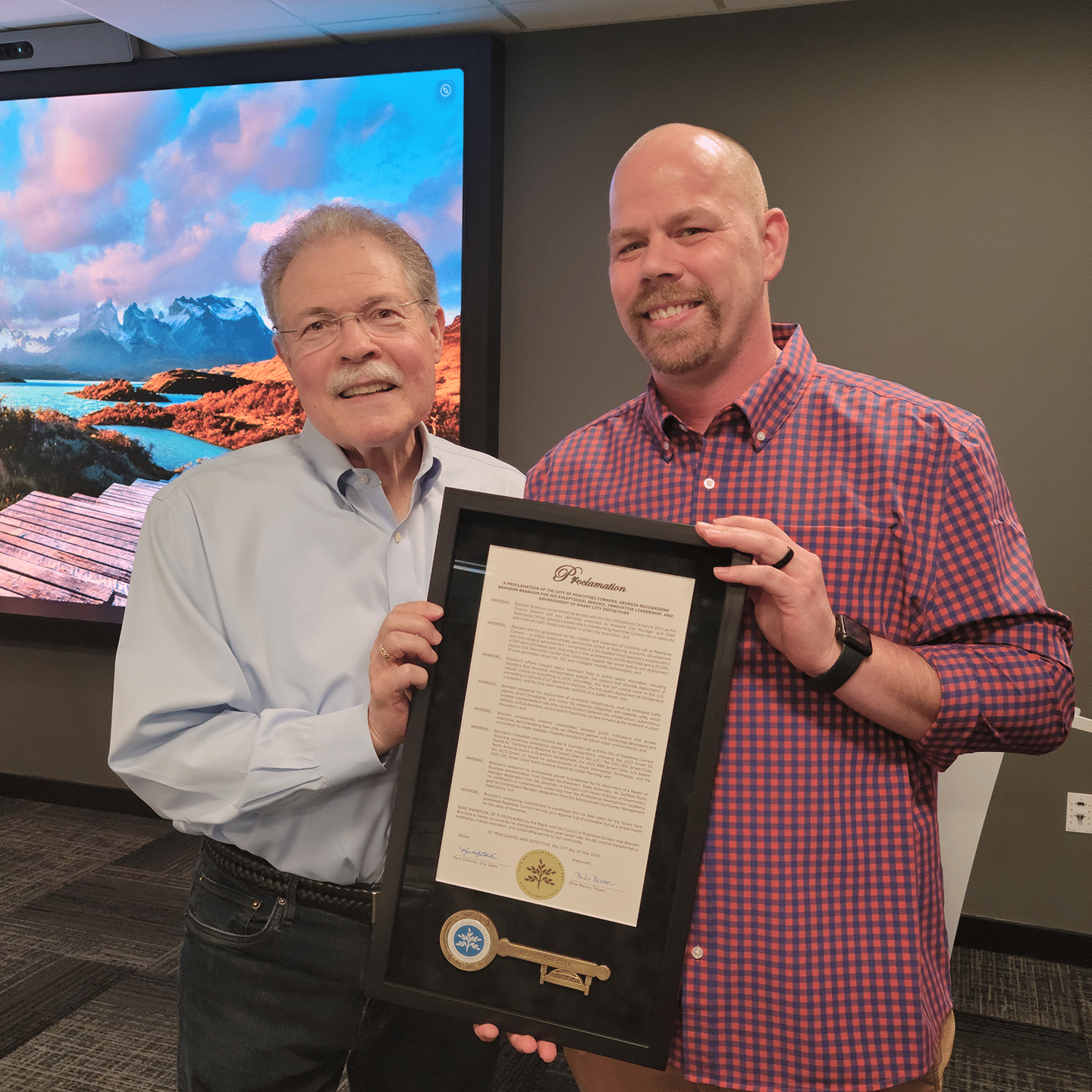
The City of Peachtree Corners recently honored Assistant City Manager Brandon Branham with an official proclamation for his years of leadership and service to the city.
Branham began his tenure in 2013 as finance director and was later promoted to assistant city manager and chief technology officer. In each of those roles, he’s played an instrumental part in guiding Peachtree Corners’ transformation from a suburban community into an internationally recognized hub of technology and innovation.
A decade of accomplishments
Among his many accomplishments, Branham spearheaded the development of the Curiosity Lab at Peachtree Corners, a 5G-enabled living laboratory and innovation center located within a 500-acre technology park.
Under his leadership, the city also achieved numerous national firsts in public sector technology, including the launch of Georgia’s first driverless shuttle system, the country’s first citywide C-V2X (cellular vehicle-to-everything) deployment and the first solar roadway installed on a public street.
“Brandon’s vision and commitment to innovation have positioned Peachtree Corners at the forefront of smart city development not just in Georgia, but across the nation,” said City Manager Brian Johnson. “His leadership has shaped the future of our city, and we are deeply grateful for his service.”
Partnerships and collaborations
Throughout his twelve-year career with the city, Branham emphasized collaboration between the public and private sectors, creating partnerships with tech companies and academic institutions to pilot scalable, real-world solutions.
His efforts have garnered numerous accolades for Peachtree Corners, including multiple Smart Cities awards and recognition for urban planning and intelligent mobility technologies.
New opportunities
Now, as Branham prepares to leave his role and move on to new opportunities, the City of Peachtree Corners “extends its heartfelt appreciation and best wishes for his continued success.”
“Brandon has left a lasting legacy,” Johnson said. “We look forward to seeing the impact he’ll continue to make in the smart city space and beyond.”
Related
City Government
Peachtree Corners Hosts Discussion About the Future of Local Policing
Published
2 weeks agoon
May 12, 2025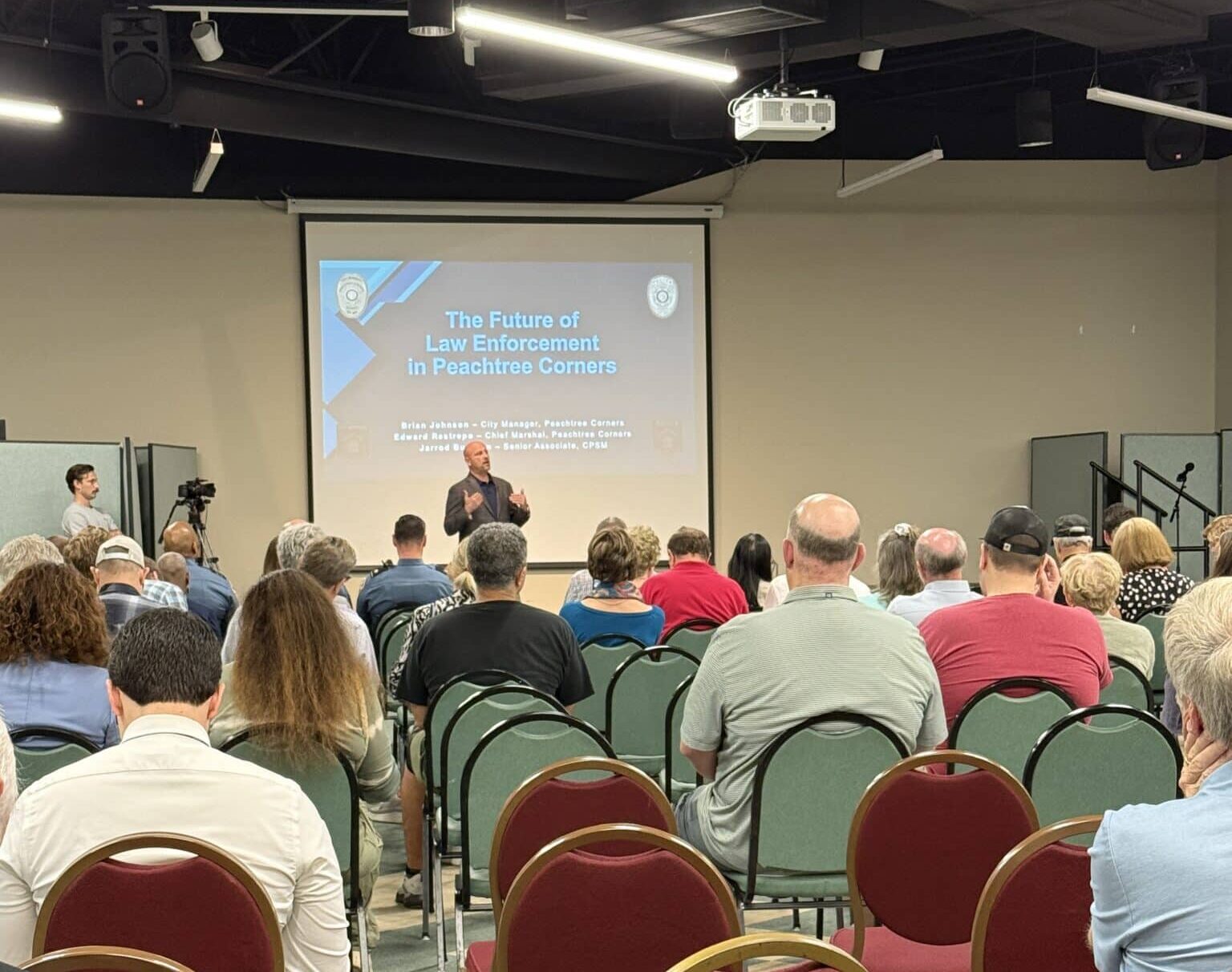
Although crime isn’t on the rise, and the Gwinnett County Police Department (GCPD) is fulfilling its role in fighting crime, the City of Peachtree Corners is asking residents, business owners and city stakeholders if they believe the city should form its own police department.
With over 100 people in attendance, City Manager Brian Johnson led the discussion about the future of policing in Peachtree Corners. He presented the findings from a survey conducted by the Center for Public Safety Management (CPSM), a nationally-recognized law enforcement consulting and training firm, as well as information about patrol officer staffing, response times, costs to tax payers and a potential timeline.
Ensuring public safety
Johnson kicked off his presentation by explaining that it is the duty of the mayor and city council to ensure public safety, including reviewing law enforcement.
“Maybe it needs to grow, maybe it needs to change its focus. But city council is the one that has the decision-making responsibility,” he said.
He was also adamant that this isn’t a done deal.

“I hit this point already, but I want to hit it again. This is the start of a conversation, a community conversation and feedback to council. There hasn’t been a decision,” he said. “Council has not received this presentation from me. They’re here to watch and learn from your feedback of this.”
Mayor Mike Mason was present at the meeting, along with all of the city council members except Eric Christ who was out of town and watching remotely.
Issues and obstacles
Johnson explained that the grounds for the inquiry were based on issues about communication, access to information and enforcement of city-specific ordinances. He cited an example where a city rule that private residences can’t be rented on a short-term basis like Vrbo or Airbnb wasn’t enforced by GCPD. An owner tried to circumvent the ordinance by only renting the outside of the house. A loud pool party ensued, and frustrated neighbors dialed 911.
“Officers showed up and they said, ‘We can’t enforce the city’s noise ordinance,’” Johnson said.
The first stage to fix this problem was creating the marshal program to bridge the gap between code enforcement and GCPD.
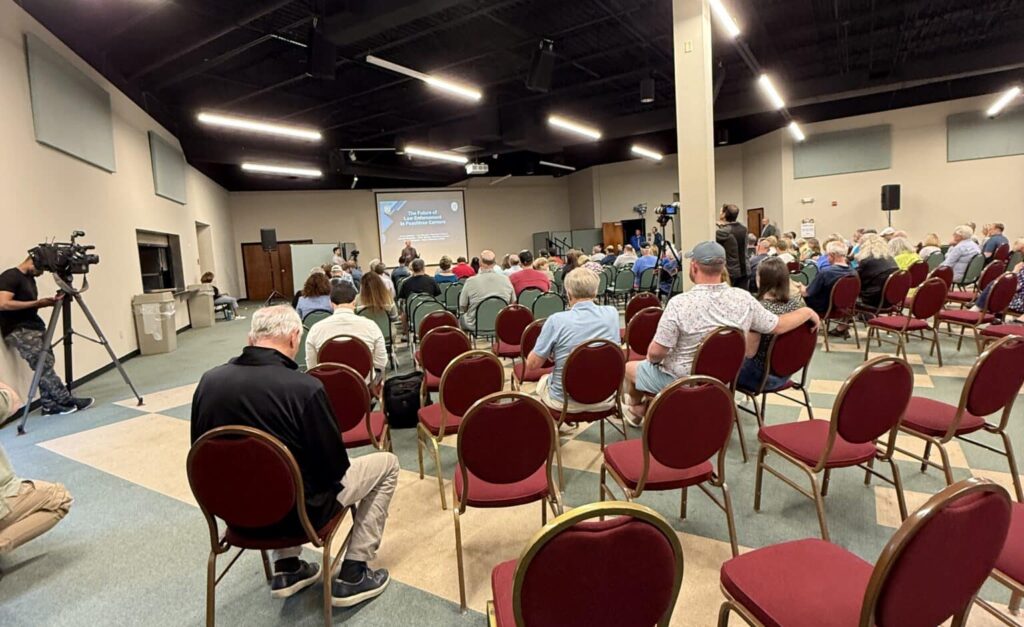
“[We thought] they would be able to enforce both local ordinance and state law, since they are a function of the city, and they could maybe be a force multiplier for Gwinnett since [marshals] don’t have to respond to 911 calls,” said Johnson.
But other issues arose shortly after the department was formed.
“We were still working towards getting that good balance, but we have been faced recently with a couple of things that make it harder for us,” said Johnson.
Seeking shared access
Instead of GCPD giving PTC marshals read-only, quick access to incident reports, dispatch calls and other information, the marshals department was required to file open records requests through the same process as any civilian.
“They were denied, as well as the city of Sugar Hill, [when] asked for the ability to see, not change, but see the computer-aided dispatch information, so that they would know where Gwinnett County police officers were; so that they could avoid stepping on their toes or maybe looking to support their efforts, and they haven’t been granted that,” said Johnson.
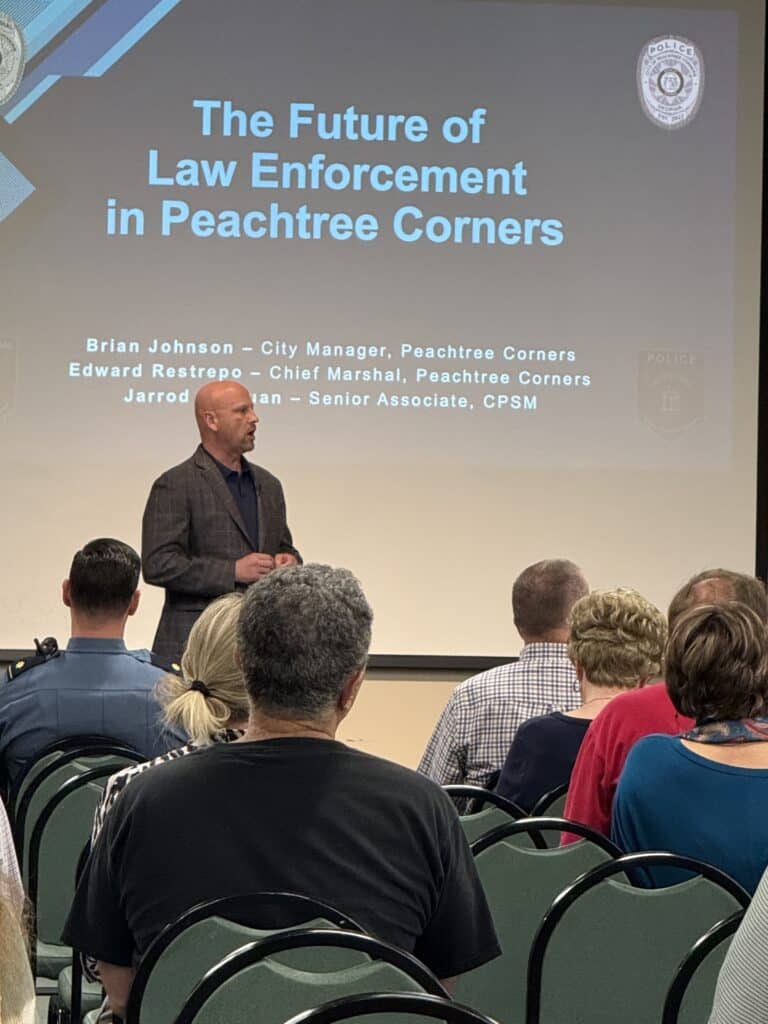
He added that the GCPD has video cameras on certain roadways that are used for various reasons, and law enforcement can use them when there’s crime in the area. Peachtree Corners marshals were denied access to those cameras.
“Conversely, we have a couple hundred cameras in the city, and we definitely want them to have access to them,” said Johnson. “So the frustration out of not being able to get that symbiosis between the marshals and police made us start thinking, all right, you know, is there another option?”
Community feedback
CPSM utilized data from GCPD to discern if Peachtree Corners could feasibly stand its own force. It also took into consideration crime trends, costs and many other factors. It recommended a 55-officer department, costing $12.1 million annually, with a $2.2 million upfront cost.
Comparing the two options to “renting vs. owning” the primary law enforcement agency in the city, Johnson presented pros and cons for each. Once the question-and-answer portion began, there was no obvious choice. Men and women, young and more advanced in age, had both similar and differing opinions.
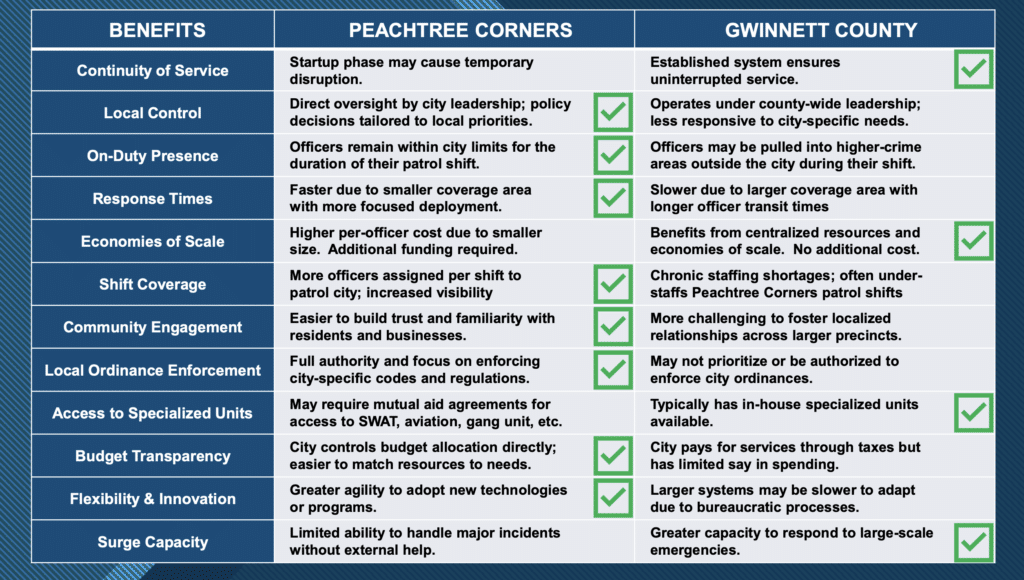
One young man, who identified himself as a local small business owner named Alexander, argued that with artificial intelligence increasing the efficiency of administrative tasks, perhaps the city wouldn’t need a full 68-man department of civilians and sworn officers.
Some accused the city of devising a solution in need of a problem. Others were concerned that paying approximately $100,00 for a study was throwing good money after bad.
But at the end of it all, the city is continuing to seek feedback and is encouraging everyone to make informed decisions. The meeting was taped and is available on the city website along with Johnson’s PowerPoint presentation, a copy of the study done by CPSM and a survey.
As far as a timeline goes, city officials would like folks to take the summer to mull it over and come back in the fall to take another look at the proposal.
Related
City Government
City of Peachtree Corners Awarded Certificate of Achievement From GFOA for Seventh Straight Year
Published
3 weeks agoon
May 9, 2025
The City of Peachtree Corners’ finance department has been awarded a Certificate of Achievement for Excellence in Financial Reporting from the Government Finance Officers Association of the United States and Canada (GFOA) for its 2024 financial year-end comprehensive annual financial report (CAFR).
The GFOA’s Certificate of Achievement is the highest form of recognition in governmental accounting and financial reporting, and its attainment represents a significant accomplishment by a government and its management.
It is the city’s seventh year of receiving the award and represents a significant accomplishment by the city’s finance department and its leadership.
According to a GFOA release, “The report has been judged by an impartial panel to meet the high standards of the program, which includes demonstrating a constructive ‘spirit of full disclosure’ to clearly communicate its financial story and motivate potential users and user groups to read the report.”
“We are pleased to again receive this honor,” said City Manager Brian Johnson. “Our finance department, and Finance Director Cory Salley, are to be commended for this achievement, as it is the highest form of recognition GOFA presents.”
A comprehensive annual report
The city’s finance department produces the CAFR each year and works with independent auditors to verify the city’s financial situation and standing.
“This prestigious award affirms Peachtree Corners’ dedication to exceeding basic requirements by producing comprehensive annual financial reports that reflect a strong commitment to transparency and full disclosure,” said Assistant City Manager Brandon Branham.
About the GFOA
The Government Finance Officers Association (GFOA), founded in 1906, represents public finance officials throughout the United States and Canada.
The association’s more than 20,000 members are federal, state/provincial and local finance officials deeply involved in planning, financing and implementing thousands of governmental operations in each of their jurisdictions. GFOA’s mission is to advance excellence in public finance.
To learn more about the GFOA, visit gfoa.org.
For more about the City of Peachtree Corners, visit peachtreecornersga.gov.
Related
Read the Digital Edition
Subscribe
Keep Up With Peachtree Corners News
Join our mailing list to receive the latest news and updates from our team.
You have Successfully Subscribed!

MomoCon 2025 to bring 60,000 Fans to Atlanta for a Weekend of Cosplay, Animation, Gaming and Music

From Boardrooms to the Himalayas: Vandana’s Journey to Purpose and Growing with Intention [Podcast]

Local Special Olympics Pickleball Team Honored with State House Resolution

Music Matters Productions Expands Peachtree Corners Headquarters

Brandon Branham Honored for Transformative Leadership in Peachtree Corners

Guardians of the Jukebox to Play the VoxStage on May 31

Celebration and Community: ICAGeorgia Wraps Up School Year with Two Festive Events

“Geek Culture” Shines at 2025 MomoCon

Vox-Pop-Uli Launches RED Initiative for Veterans’ Support

The PCBA Awards $500 to Light Up The Corners at After-Hours Event

“Geek Culture” Shines at 2025 MomoCon

Celebration and Community: ICAGeorgia Wraps Up School Year with Two Festive Events

Guardians of the Jukebox to Play the VoxStage on May 31

Music Matters Productions Expands Peachtree Corners Headquarters

Brandon Branham Honored for Transformative Leadership in Peachtree Corners

From Boardrooms to the Himalayas: Vandana’s Journey to Purpose and Growing with Intention [Podcast]

Light up the Corners [Video]

Capitalist Sage: Business Leadership in Your Community [Podcast]

Cliff Bramble: A Culinary Adventure through Italy

Top 10 Brunch Places in Gwinnett County

A Hunger for Hospitality

THE CORNERS EPISODE 3 – BLAXICAN PART 1

Top 10 Indoor Things To Do This Winter

The ED Hour: What it takes to Remove Barriers from Education










